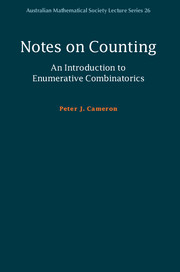Book contents
- Frontmatter
- Contents
- Preface
- 1 Introduction
- 2 Formal power series
- 3 Subsets, partitions and permutations
- 4 Recurrence relations
- 5 The permanent
- 6 q-analogues
- 7 Group actions and the cycle index
- 8 Möbius inversion
- 9 The Tutte polynomial
- 10 Species
- 11 Analytic methods: a first look
- 12 Further topics
- 13 Bibliography and further directions
- Index
2 - Formal power series
Published online by Cambridge University Press: 28 June 2017
- Frontmatter
- Contents
- Preface
- 1 Introduction
- 2 Formal power series
- 3 Subsets, partitions and permutations
- 4 Recurrence relations
- 5 The permanent
- 6 q-analogues
- 7 Group actions and the cycle index
- 8 Möbius inversion
- 9 The Tutte polynomial
- 10 Species
- 11 Analytic methods: a first look
- 12 Further topics
- 13 Bibliography and further directions
- Index
Summary
Formal power series are central to enumerative combinatorics. A formal power series is just an alternative way of representing an infinite sequence of numbers. However, the use of formal power series introduces new techniques, especially from analysis, into the subject, as we will see.
This chapter provides an introduction to formal power series and the operations we can do on them. Examples are taken from elementary combinatorics of subsets, partitions and permutations, and will be discussed in more detail in the next chapter. We also take a first look at the use of analysis for finding (exactly or asymptotically) the coefficients of a formal power series; we return to this in the last two chapters. The exponential, logarithmic and binomial series are of crucial importance; we discuss these, but leave their combinatorial content until the next chapter.
Fibonacci numbers
Leonardo of Pisa, also known as Fibonacci, published a book in 1202 on the use of Arabic numerals, then only recently introduced to Europe. He contended that they made calculation much easier than existing methods (the use of an abacus, or the clumsy Roman numerals used for records). As an exercise, he gave the following problem:
At the beginning of the year, I acquire a new-born pair of rabbits. Each pair of rabbits produces a new pair at the age of two months and every subsequent month. How many pairs do I have at the end of the year?
Let Fn be the number of pairs of rabbits at the end of the nth month. Then F0 = 1 (given), and F1 = 1 (since the rabbits do not breed in the first month of life). Also, for n ≥ 2, we have
since at the end of the nth month, we have all the pairs who were alive a month earlier, and also new pairs produced by all pairs at least two months old (that is, those which were alive two months earlier).
- Type
- Chapter
- Information
- Publisher: Cambridge University PressPrint publication year: 2017

